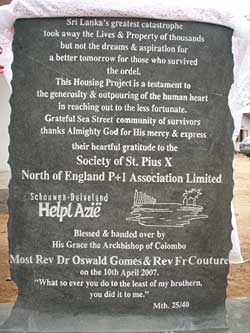

![]()
![]()
|
Newsletter of the District of Asia Jan - April 2007 Editorial Dear Friends and Benefactors, At the time of writing, there is still nothing new about the famous Motu Proprio which we are all expecting in the spirit of doubting Thomas (!) and which would give more freedom to the Traditional Mass. It is obviously impossible then to comment on it, as Bishop Fellay says in his Letter to Friends and Benefactors (see p. 4). However, as Fr. Pagliarani also wisely commented in his recent editorial of the Italian Tradizione Cattolica (no. 1 (63) 2007), we have to admit that even the man in the pew has now heard at least confusedly about this Traditional Mass, associating it in a kind of way to the work of Archbishop Marcel Lefebvre, and sees in this an indirect re-habilitation of the latter’s work. On the other side, the rather violent reaction of the episcopacy in many countries against such papal act lead us to the following reflections: It seems very difficult to believe that such liberty given to the old Mass be unconditional: in fact the present Holy Father—in perfect harmony with the modern principle of collegiality— is extremely attentive to the reactions and the feelings of the bishops.
The souvenir plaque unveiled by Fr. Couture
Finally, if we do not know exactly the interior motives of the Holy Father in heading in the present direction, and what he will do precisely in the near future, though he does not hide a deep appreciation of the pre-conciliar liturgy, however from his various speeches and writings of the last two years, it is evident that the simple thought of the possibility of calling into question the Council is outside the scope of his plans. According to a recent interview (April 17, 2007) of a priest working for Radio Vatican in its German section, Fr. von Gemmingen, there is in this awaited act of Benedict XVI no absolute will to restore an ancient practice, nor the will to turn the back to Vatican II. On the contrary, says this priest, “the Pope is the guarantor of Vatican II.” Then he goes on to explain that the Holy Father is pulling both sides, the liberals and the traditionalists, to accept the real Vatican II, which is simply living Tradition today. It is the compromise between two ‘extreme positions’, in good Hegelian praxis. The problem with such an approach was highlighted by Archbishop Lefebvre many years ago. Modernism is never static, it always moves: that is why we are being reproached for a wrong notion of Tradition: “4. The root of this schismatic act can be discerned in an incomplete and contradictory notion of Tradition. Incomplete, because it does not take sufficiently into account the living character of Tradition, which, as the Second Vatican Council clearly taught, ‘comes from the apostles and progresses in the Church with the help of the Holy Spirit.’ ” (Ecclesia Dei Adflicta, 1988) The Archbishop replied one day to the then Cardinal Ratzinger who was telling him to accept the “Church of today”: “But Eminence, tomorrow, today’s Church will be of the past, it will be yesterday’s Church. We will have to change again!” They are objecting our attachment to pre-Vatican II Tradition on the ground that now Vatican II has come. But, Vatican II is already past, ‘passé’, it is now 40 years old. By sticking to it, they fall in the same objection they are making to us: they are clinging to the Church at a particular moment in history. According to this modernist principle, they should stop referring to Vatican II and look for something else! This is why their notion of Tradition is in itself contradictory, and not the notion of Tradition Archbishop- Lefebvre—and 2000 years of Church Magisterium— stood for. To our great displeasure, we have to admit that Benedict XVI is indeed the successor of Pope John Paul II, not just historically but especially in the main lines of his theological thinking, particularly in the field of ecumenism and of religious liberty. His visit to the Blue Mosque, in Istanbul, last November 30, where he prayed turned towards La Mecca, cannot be interpreted as the mere gesture of a tourist. Our Blessed Lord cannot be present, nor be named or witnessed to in such a place. And if He is not welcome, what is His Vicar doing there? It was a sad day for the Bride of Christ. We want Our Lord Jesus Christ, and we want Him openly, to reign both in Istanbul as in La Mecca, everywhere. And we want to communicate Him to all men– ‘omnia in omnibus: all things to all men’– to the Jews and to the Muslim, to all, in the name of the true fraternity which has only one name: supernatural charity. Anything that doesn’t lead in that direction in unacceptable. We are not fighting for the triumph of a liturgical rite, albeit sacrosanct and of an immemorial custom. The rite of Mass is not everything: Our Blessed Lord Jesus Christ alone is everything, “the Way, the Truth, the Life” (Jo. 14,6). We want the unconditional triumph of Our Lord Jesus Christ, of His Virgin Mother, and of His Immaculate Spouse, the Holy Catholic Church. |

